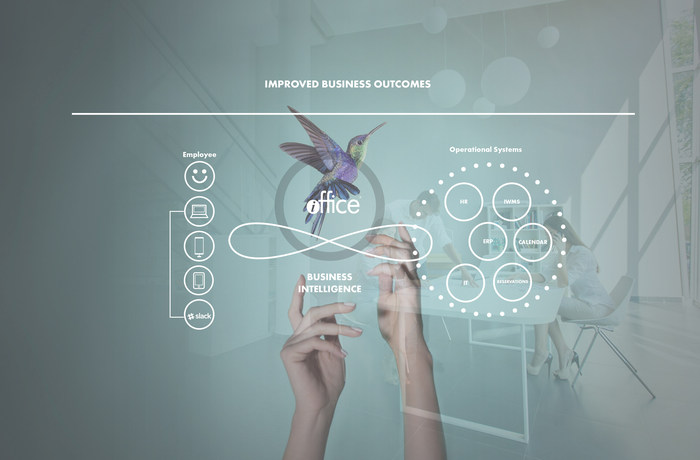Want A Connected Workplace? The Secret is in Your Pocket

The secret to creating and controlling a connected workplace is probably sitting in your pocket. Our phones are powerful tools – even tracking how long we spend on them, for better or for worse. But what if we could use our phones for more than filling downtime? What if we could use them to control an enterprise?
Controlling Your Workplace from Your Phone
In the past, mobile technologies were focused on meeting room reservations; then came lighting, heating and cooling, then access control. Over the last 24 months, it has become apparent that there are many more occupant experiences that can be delivered via mobile phone. Managing parking, reporting maintenance issues, ordering coffee, scheduling an exercise class, viewing security cameras and other applications have all been quickly added to the list.
With so many options and approaches available, what are the best strategies for the occupant experience? Build versus buy, functionality selection, solution integration and ongoing support are just some options that facilities and CRE /leaders need to wrestle with today.
The Engagement Opportunity
The mobility opportunity is the engagement opportunity. Although the technology devised in recent years is incredibly exciting, it’s important to take a step back to think about what your organization really needs to be a connected workplace. Plain and simple, the connected workplace is for the employee, but we have a crisis at hand – employees are disengaged and it’s hurting the bottom line.
- Only 34% of active employees are engaged
- Disengaged employees cost organizations between $450 and $550 billion per year
- Companies with engaged employees see 233% greater customer loyalty and a 26% greater annual increase in revenue
By creating an institutional infrastructure that works across silos, collects data and gives employees access to the mobile tools they need to work efficiently, you’re creating an environment where everyone wins. Whether they’re in the office, working remotely or even on the go at 30,000 ft.
Creating a Connected Workplace
You’ve heard the buzzwords: the “digital workplace” and the “smart workplace,” but it’s the connected workplace for which we should strive. The connected workplace creates a frictionless experience between people, spaces and technology. That seamless interface comes from user-friendly, SaaS-based technology that connects across departments and makes work more productive, satisfying and responds to how we work today and in the future. It also holds the promise of easily connecting with the systems that you already have and adding mobile tools that employees crave.
The expectation today is that everything is accessible everywhere. This is a non-negotiable in the connected workplace because work is happening everywhere. And it’s more DIY driven, which means that employees are now able to handle requesting and getting the services they need, often without needing FM teams or the built environment to do it for them.
Thanks to IoT and AI, connecting via mobile devices is as easy as connecting to desktop devices. With the advent of Activity-Based Working – employees are rarely in the same place consistently and so the tech and services must fit into the employee’s pocket for them to be productive. Although that seems well and good, the process for implementing such a monumental change can at first, seem overwhelming.
Best Strategies for Mobile
- First, it’s not necessary to rip and replace what you have now to get the connected mobile workplace. Start by asking the right questions. Most customers create a cross-functional task force with HR, IT, FM, CRE and Corporate Communications to determine which departments and employees need what. Set out clear goals based on the goals of the built environment’s performance, the needs of the employees and the ability to collect data and business intelligence to plan for the future.
- Next, get granular about the functionality selection and which solutions need to integrate and collaborate across silos. Set up a dream list of data and apps sharing. Then, get realistic about what you can and can’t implement with realistic deadlines and support. By the way, this is a great time to streamline your tech stack. You'd be surprised what lives in there [and what your employees are already downloading just to do their work better.]
- Finally, consider training and adoption. Frankly, we hate training, don't you? At iOFFICE, we believe that all mobile technology should be as easy to operate as your cell phone. Virtually no training required should be the standard. Ask, is it instantly usable? Does it sync everywhere? Could my newest employee learn it and teach it to the next newbie on the same day?
The results will make everyone more productive and focused on activities that bring real value and return a clear ROI to the organization as a whole. In short, mobile adoption is key if you want to keep your employees engaged. What better way is there to enhance employee experience than to give them tools that are with them all the time. It might make their weekly screen time go up, but they just might like coming to work, a little bit more as a result.
This Week’s Sponsor
iOFFICE equips workplace leaders with data and mobile tools to plan for the future of their connected workplace. Hummingbird is an EX solution and app that connects employees to everything they need while collecting data—resulting in greater productivity and satisfaction. Learn how more than 2.4M users at 1,400 companies use iOFFICE to create productive workplaces: www.iofficecorp.com.
Read Next
 5/15/2025
5/15/2025
Tech, Talent and Transformation: 2025 Digie Finalists Announced For 27 years, Realcomm has presented the Digie Awards to acknowledge companies, real estate projects, technologies, and individuals that have advanced the commercial real estate industry through the strategic use of technology, automation, and innovation.
 5/15/2025
5/15/2025
Empowering Space Management with Data-Driven Visualization For effective CRE space management, it’s critical to centralize lease data, maximize rental square footage (RSF), improve energy efficiency and reconfigure spaces to meet changing needs.
 5/8/2025
5/8/2025
The AI-Powered Workplace Evolution: Redefining the Business Landscape In today's rapidly evolving business environment, the fusion of Artificial Intelligence (AI) and Workplace Management is revolutionizing the way organizations approach workspace optimization and operational efficiency.
 3/27/2025
3/27/2025
The Convergence of Edge Computing, Cloud, and AI in Building Automation and Smart Buildings In the built environment, we have seen the convergence of Operational Technology (OT) and Information Technology (IT), later expanding to include Workplace Technologies (WP).



%20(1)%20(1)%20(1).png)







